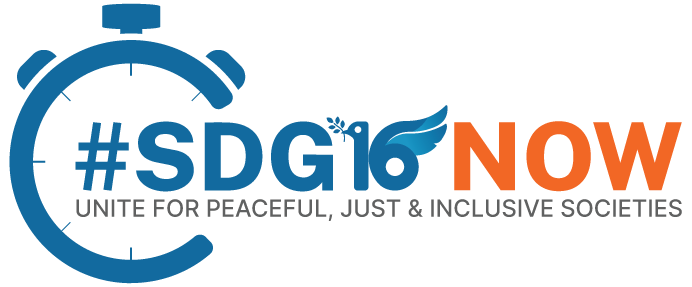Target 16.4: By 2030, significantly reduce illicit financial and arms flows, strengthen the recovery and return of stolen assets and combat all forms of organized crime
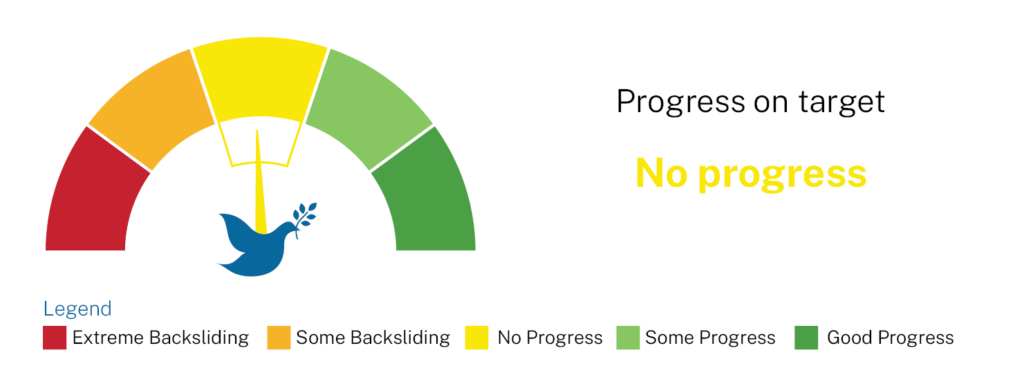
There are serious challenges with progress on this target. The indicators are inadequate and official data is scarce. There is some progress on monitoring illicit financial flows (IFFs) and the establishment of beneficial ownership registries. The pervasiveness and widespread nature of all types of illicit economies show that the overall aim of combatting all forms of organised crime remains out of reach. More than three quarters of the global population live in countries with high levels of criminality.
Authors of chapter





Context and Interlinkages
Target 16.4 covers four overlapping but distinct issues: illicit financial flows, illicit arms flows, stolen assets, and combating organized crime. Together, these are some of the most difficult issues facing the world which each undermine sustainable development.
Many billions of dollars are stolen each year from governments and moved internationally. The UN estimates the funding gap – the difference between funds needed to reach the SDGs and the amount currently available – to be $4 trillion per year for all countries.1 For developing nations, who need every available dollar to reach the SDGs, this is especially concerning. Illegal flows of weapons undermine peace in fragile countries around the world, increasing the difficulty of achieving the 2030 Agenda. Organized crime often undermines efforts at peace and stability through violence, arms sales, corruption and illicit financial flows. While finding and returning stolen assets – often originally transferred internationally though illicit financial flows (IFFs) – can be used to fund development projects.
Each of these has deep links to other SDG Goals. The IFF target is linked closely to SDG Target 17.1 which calls on governments to “strengthen domestic resource mobilisation, including through international support to developing countries, to improve domestic capacity for tax and other revenue collection”. Targets 16.5 on corruption and 16.6 on effective, accountable and transparent institutions at all levels are linked to reducing IFFs and fighting organized crime since low levels of transparency and weak institutions often facilitate corruption and tax evasion. The fight against Transnational Organized Crime (TOC) is also strongly linked to arms (16.4.2), peace and violence (16.1) and SDG16+ Target 8.7 on modern slavery and human trafficking. Public access to information (16.10) underpins the fight against IFFs, organized crime, and illegal arms sales, and facilitates oversight on the return and use of stolen assets.
The target is also reinforced by numerous international conventions including the United Nations Convention against Corruption (UNCAC), the United Nations Convention against Transnational Organized Crime (UNTOC), and the Arms Trade Treaty. IFFs also tie into the Addis Ababa Action Agenda.
Progress on indicators
Official Indicators:
- 16.4.1: Total value of inward and outward illicit financial flows (in current USD) (Tier II)
- 16.4.2: Proportion of seized, found or surrendered arms whose illicit origin or context has been traced or established by a competent authority in line with international instruments (Tier II)
Additional Indicators:
- Global Organized Crime Index
- Small Arms Trade Transparency Barometer
- Stolen Asset Recovery (StAR) Initiative data on return of proceeds of corruption
Illicit Financial Flows (16.4.1) are defined as “financial flows that are illicit in origin, transfer or use, that reflect an exchange of value, and cross country borders”.2 Since 2015, there has been significant progress by the UN to develop the indicators and statistical framework to begin to measure IFFs. However, there is currently no official data for this indicator, as UN agencies only received endorsement from the UN Statistics Commission for a new framework for measurement in 2022.3 Once it is fully in place, 16.4.1 will be a valuable indicator of the magnitude of illicit flows and will grant policy planners, economists and researchers a fuller understanding of the entire development equation (i.e. total money flowing into a country and total money flowing out). These figures can then be netted which will provide a final figure to be used for programme investment and for addressing the SDG targets.
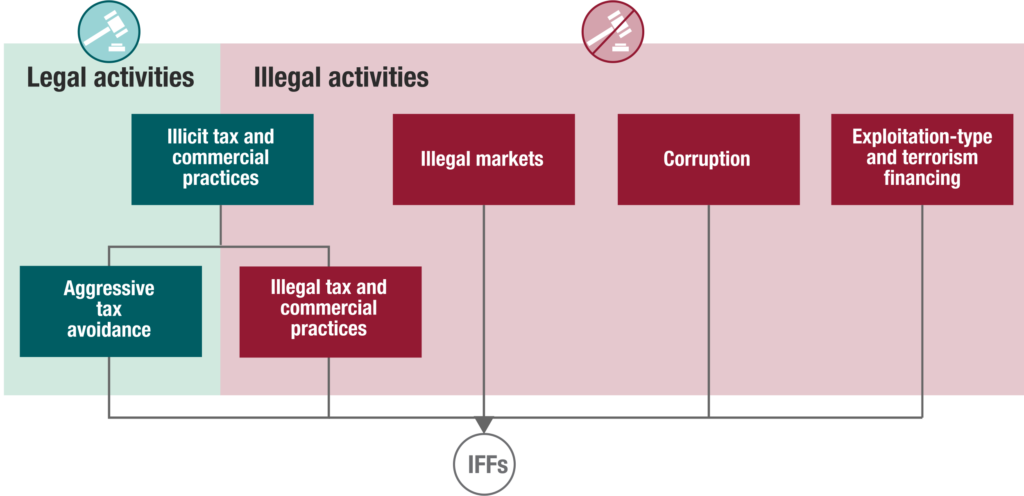
Source: UNCTAD, https://sdgpulse.unctad.org/illicit-financial-flows/
Further, donor countries are providing substantial financial support to help resource-rich developing nations to build capacity that will enable them to implement policies and procedures to ensure more transparency mechanisms in the sector which, it is hoped, will boost domestic resource mobilisation. There indication of progress regarding the establishment of beneficial ownership registries is also evident, given over 100 governments have committed to implementing these reporting requirements.
It is estimated that the global total for trade-related illicit flows is approximately $1.6 trillion yearly4 with developing countries having lost USD 16.3 trillion between 1980 and 2012.5 There is some official data on several of the components: The UN estimates corruption at about $3.6 trillion;6 the OECD estimates tax losses between $100 and $240 billion7, and the United Nations Office on Drugs and Crime (UNODC) estimates criminal activity at 1.5 per cent of global GDP or about $1.7 trillion.8
Official data is also scarce for illegal arms flows (16.4.2) of which the official indicator only relates to traceability. The heading for this indicator in the 2022 SDG Extended Report was “countries still face significant challenges when establishing the illicit origin of firearms”. Few countries have systems in place to trace such origins, and even those that do are not fully successful in the pursuit. The UNODC, in a survey of 20 member states from 2016 to 2020, found that authorities successfully traced an average of 28 per cent of seized weapons that were potentially traceable.9
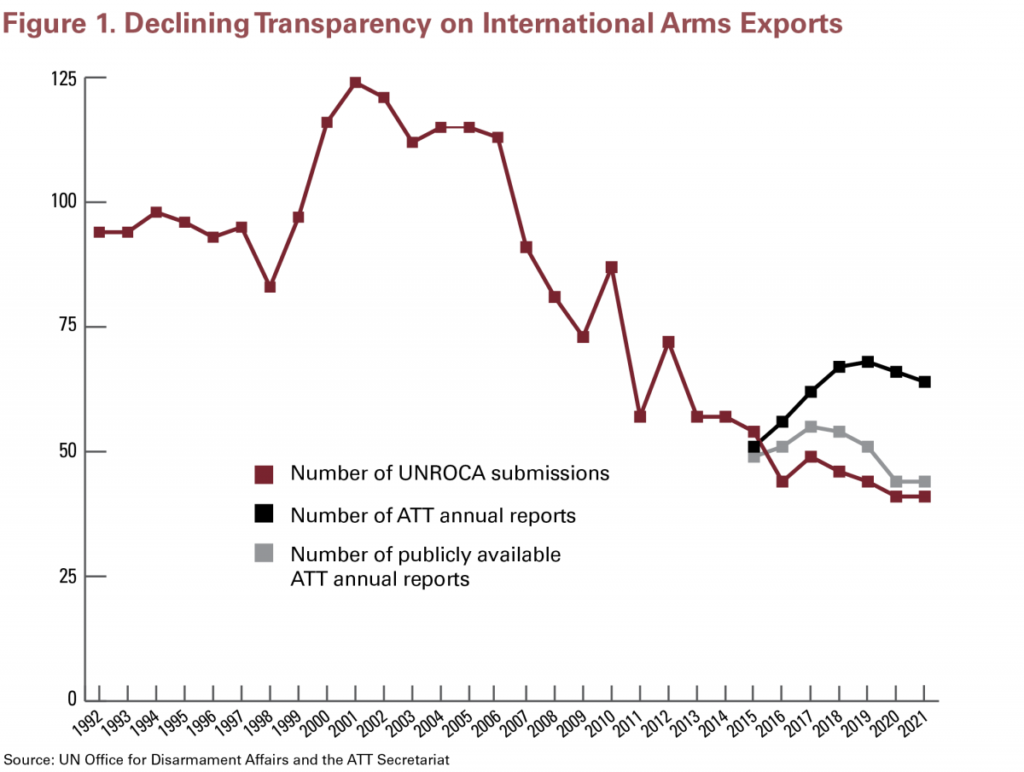
There is an estimated $100 billion worth of weapons transferred every year. The 2021 Global Organized Crime Index found that the trafficking of arms was the third most pervasive criminal market worldwide. This particular form of criminality was highlighted not only for fuelling violence, but for its contribution to furthering other illicit markets and the influence of criminal groups.
Between 2015 and 2022, 26 countries joined the Arms Trade Treaty (ATT), bringing its total number of parties to 111. The ATT Monitor reports that there is a growing trend of states keeping their reports confidential.10 The Small Arms Trade Transparency Barometer which assesses the transparency of top and major exporters – states which are believed to have exported at least USD 10 million worth of small arms and light weapons – found that average transparency scores increased slightly between 2020 and 2021, but that many countries are failing to report sales to the United Nations Register of Conventional Arms and are keeping reports submitted to the Arms Trade Treaty secret.11 The number of country reports submitted to the UN Register dropped significantly between 2000 and 2020, to nearly a third of the number submitted on average in the early 2000s, before going up again in 2021.12 Moreover, recent developments in the trafficking of a range of ‘privately manufactured firearms’ – including craft weapons, ghost guns, converted alarm pistols, and 3D printed firearms – complicate law enforcement as well as efforts to monitor illicit flows, as such weapons are produced outside of factory settings and sometimes directly by the unauthorised end-users themselves.13
16.4.2 focuses on states’ efforts to trace weapons and does not directly measure the extent of arms trafficking or diversion. Considering other proxy indicators may therefore help to monitor different aspects of what is, in any case, a complex and multifaceted type of illicit flow. Poor ammunition stockpile management practices can enable the diversion of state-owned weaponry and ammunition, for instance. As such, the occurrence and high human toll of unplanned explosions at munitions sites14 can reflect poor stockpile-management practices in certain settings and therefore indicate a higher risk of diversion. Similarly, the proportion of homicides perpetrated by firearms can provide insights into criminals’ abilities to access these weapons, over time and across regions.15
Additional Indicators
The official indicators for 16.4 do not address the issue of the tracing and return of stolen assets. Many states release no or inadequate information about their asset-recovery efforts and the public in the affected jurisdictions are therefore often unable to track individual asset-return cases. Similarly, available data on global progress in the return of stolen assets remains sporadic, but it seems clear that only a small fraction of stolen assets and proceeds of corruption are recovered and returned.
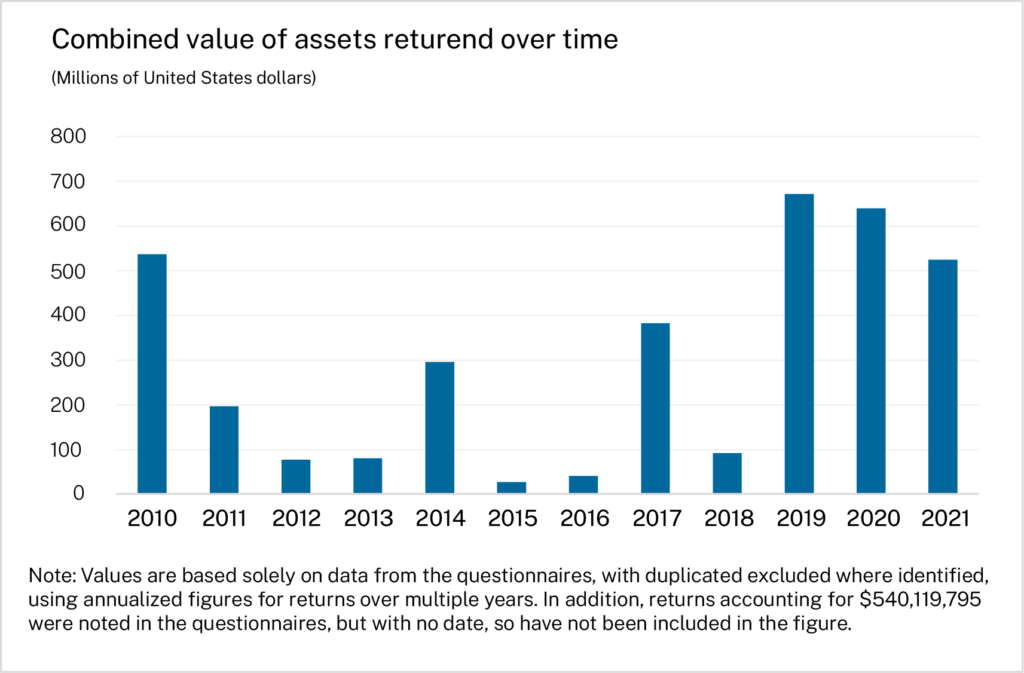
Source & Graphic: StAR: Collection of information on international asset returns, including challenges, good practices and lessons learned (2022), p10.
Data collected by the World Bank’s and the UNODC’s Stolen Asset Recovery Initiative (StAR) suggests slightly higher return volumes of proceeds of corruption from 2017 to 2021 than in prior years. However, single cases have a large impact on the global total volume of returned assets. Furthermore, cases take numerous years to proceed. Recent research from StAR identified USD 4.16 billion in proceeds of corruption that states have returned to the country of origin. In response to a survey StAR sent to states, 44 countries and jurisdictions (out of 87 that responded) reported that they had been involved in at least one cross-border asset return involving corruption proceeds between 2010 and 2021.16 A 2021 paper by StAR found that in addition to the $4.1 billion in returned assets, states had confiscated another $267 million and frozen $5.3bn between 2010 and 2021.17
While an increasing number of states enact asset-recovery legislation, more efforts by states are needed to identify, freeze and confiscate proceeds of corruption, and to return them in a transparent and accountable manner, also involving civil society in all stages of the return process.
Significantly, the indicator framework for 16.4 does not include indicators to measure how the ‘combatting’ of organized crime could be measured in general. In 2021, the Global Initiative against Transnational Organized Crime (GI-TOC) published the first-ever Global Organized Crime Index.18 The results of the Index find that the global illicit economy is booming19 and paint a worrying picture of the reach, scale and impact of organized crime. The Index found that 79.2 per cent of the global population live in countries defined by high levels of organized criminality, with state-embedded actors appearing as the most dominant criminal-actor type in the world. One of the strongest correlations emerging from the Index was found to be between the presence of state-embedded criminal actors and poor resilience. This would suggest that those actors may in fact be undermining the capacity and resilience of the state to prevent illicit flows, making them one of the most significant impediments to an effective counter organized crime strategy.
Despite the serious and global nature of this problem and the fact that there is a global instrument (UNTOC) to deal with it, international efforts remain largely fragmented, reactive, inadequate and unevaluated. Meanwhile, criminal groups are highly adaptive in seeking out new markets, opportunities and taking advantage of new technologies. The UN response to organized crime is often regarded as, in a narrow sense and separately to the SDGs, as implementing the UNTOC (with its three protocols on human trafficking, migrant smuggling, and illicit firearms manufacturing and trafficking), and its drug control regime. There is also the UNCAC, which includes linkages to transnational organized crime. However, the fight against organized crime and efforts to mitigate its impact are reflected within a much wider ambit of the UN’s goals and activities in seeking peace and security, human rights and sustainable development. A 2019 review by the GI-TOC identified a mandate to address transnational organized crime in 79 out of the UN’s 102 entities, bodies and agencies, or nearly 77 per cent.20 The mandate for addressing organized crime extends across the UN System in a way that is expansive, exhaustive and certainly under-appreciated.
The challenges faced in tackling this widespread phenomenon through the UN include strategic and programming shortcomings. On the strategic side, some examples include, the interconnections between state actors and illicit markets, the tendency among governments to securitise responses to crime, a lack of common approaches among different governments, and therefore, a lack of a common vision or strategy at the UN. On the programmatic side, there is insufficient information and analysis driving UN programming, disjointed governance and UN responses, and insufficient cooperation or jurisdiction on crimes covered by the UNTOC.21
Case Studies:
In 2022, Switzerland agreed with Uzbekistan to return at least $131 million associated with the daughter of the former Uzbek president. The funds are to be returned through the Uzbekistan Vision 2030 Fund, which aims at achieving the SDGs in Uzbekistan.22 From this Multi-Party Trust Fund, UN bodies and agencies will receive funding for projects; anticipated focus areas will be to reduce child mortality and to advance primary education in the country. Civil society has been active in advocating for the return of the stolen Uzbek funds, many of which are still located in different Western jurisdictions. A Civil Society Advisory Council, composed of representatives of national and international civil society organisations and academia, will advise the Fund and its operations.23
In France, independent NGOs are able to initiate court proceedings in corruption cases. This is facilitated in the French criminal code by the presumption of money laundering if assets are held in opaque manners to conceal their origin or ownership, and if the owner cannot provide a justification for this opaque structure. The NGOs Sherpa and TI France initiated several biens mal acquis cases which resulted in the French authorities confiscating prime real estate and other assets (worth many million Euros) linked to the Vice-President of Equatorial Guinea and a relative of the President of Syria. France has recently adopted a legal framework to allow for the return of such assets. However, the actual return of these assets has yet to take place.
Since the SDGs were implemented, substantial funds, from government donors such as Norway and Finland (among others), have been targeted to assist governments in improving “domestic capacity for tax and other revenue collection” as called for under SDG 17.1. The Washington, DC-based think tank Global Financial Integrity has been working with local partners in Colombia, Kenya and Uganda since 2019 to conduct a research-, education- and advocacy-campaign calling for the implementation of beneficial ownership registries and policies to address trade misinvoicing and trade-based money laundering which is a direct link to 17.1. While great progress has been made in establishing beneficial ownership registries – which are meant to create greater transparency of corporate vehicles in order to reduce money laundering, fraud and corruption – it is still too early to determine how much additional revenue may have been collected due to these reporting requirements.
Recommendations
Recommendations on illicit financial flows:
- The World Bank should immediately undertake an analysis using the metadata compiled by the UN to determine – on a country level – the amount of illicit inflows and outflows for all nations.
- States should set up central registers of beneficial ownership that contain verified information on who ultimately owns and controls legal entities and arrangements. These registers should, at minimum, be accessible to all relevant domestic and foreign stakeholders, including journalists and NGOs, in order to facilitate the identification of proceeds of corruption and other crimes, so they can be confiscated and returned.
- States should use block-chain technology for customs departments to prevent asymmetry in customs data from departure/arrival points.
- Create Interpol platform for Trade-Based Money Laundering (TBML) information sharing/open database for law enforcement to share details of TBML cases to help identify repeat offenders.
- Establish beneficial ownership registry for commercial shipping at the International Maritime Organisation (IMO) to advance transparency of ship owners.
Recommendations on asset recovery:
- States should introduce innovative legal tools, such as non-conviction-based confiscation mechanisms and a presumption of money-laundering if assets are held in highly opaque manners and no justification for the origin and ownership of assets can be provided.
- States should introduce and apply policies to ensure a transparent and accountable return of proceeds of corruption, in line with the GFAR principles,24 to the country of origin for the benefit of the people and communities harmed by corruption, providing adequate remedies for victims of corruption, and to support measures towards achieving the SDGs.
- States should grant independent NGOs legal standing to initiate corruption cases, representing the public interest, and pursue claims on behalf of victims of corruption, thus enabling them to trigger the confiscation of stolen assets.
- States should publicly report on actions taken to freeze, confiscate and return stolen assets and disclose agreements and other relevant documents linked to those cases.
Recommendations on arms flows:
- States should make public all annual reports submitted to the Arms Trade Treaty secretariat and submit annual reports to the United Nations Register of Conventional Arms (UNROCA).
- States should develop or strengthen their national capacity for the collection and analysis of data on illicit firearms production, diversion, and trafficking and increase their exchange of information with UNODC for the global monitoring of progress on Indicator 16.4.2.25 In doing so, they could further engage with academic and non-governmental organisations with a relevant mandate.
Recommendations on fighting organized crime:
- States should strengthen the collection and analysis of data on all aspects of organized crime, including in cooperation with relevant multi-stakeholders, to advance knowledge for effective evidence-based crime prevention policies.26
- Collect better global data on the plethora of illicit markets and criminal actors that are now a reality in order to support the implementation of inclusive and networked responses, including by creating an independent body for collecting, analysing and publishing information on TOC, and a foresight centre within the UN that looks at the impact of organized crime on development, peace and security, and brings the issue to the attention of the UN.
- Identify the building blocks of a global strategy to enhance international cooperation against transnational organized crime and be more anticipatory and strategic in order to take the first-mover advantage away from criminals, especially in relation to new technologies.
- Break down silos between corruption and organized crime: seek more interlinkages between the UNCAC and the UNTOC, and their implementing bodies.
- Support community resilience: scale up support for local actors; mainstream resilience to organized crime into peacebuilding and initiatives to create safer communities; engage the private sector and civil society more actively to enhance community resilience.
- Extend crime prevention and crime-fighting networks beyond the current multilateral system to include a wide range of actors, including local activists, mayors, academics, law enforcement and the private sector. Ensure that civil society – and particularly those most affected by organized crime – have opportunities for effective participation.

Resources
- UNCAC Coalition: Working Group on Asset Recovery
- UNCAC Coalition: Asset Recovery Page
- UNCAC Coalition: National UNCAC implementation reviews on asset recovery
- UNCAC Coalition: National UNCAC implementation reviews on civil society parallel reports
- World Bank: StAR Initiative
- ATT Monitor and OXFAM: Goals Not Guns: How the Sustainable Development Goals and the Arms Trade Treaty are Interlinked
- UNODC: Technical Assistance and Capacity Building in Various Regions
- UNSC54: Side Event "Measuring Illicit Financial Flows" recording of the global experiences meeting
- HLAB: A Breakthrough for People and Planet - Effective and Inclusive Global Governance for Today and the Future
